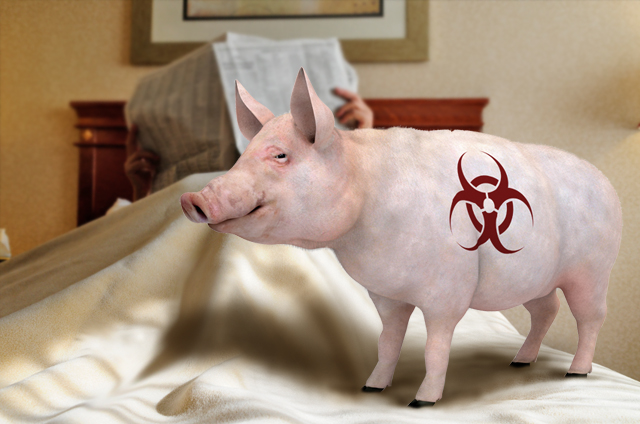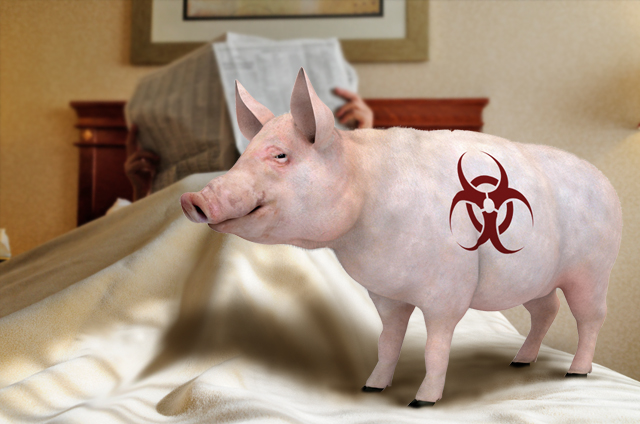 Photo illustration by Tom Twigg / Grist
Photo illustration by Tom Twigg / Grist
Swine flu: how very two weeks ago.
Sure, H1N1 transmission is “still on the upswing” in the United States, and the World Health Organization warned that as much of a third of the globe’s population could eventually catch it, Reuters reported last week.
But the disease is turning out to be little more virulent than the common flu. It resists older anti-viral treatments, but fortunately, new ones like Tamiflu have its number. For now, anyway. “We all pray this remains sensitive to antivirals,” CDC chief virologist Rubin Donis recently told Science — not exactly inspiring confidence.
Thus sensationalist media spotlight on swine flu is beginning to fade. Out of sight, out of mind. In our culture of instant amnesia, the 2009 swine flu outbreak appears to be skulking into the shadows to join such forgotten one-time burning media fixations as the Teri Schiavo and Elian Gonzalez episodes.
Worrying about future outbreaks, it seems, is for professionals. “Vast amounts of time and resources are being invested in planning for the next influenza pandemic,” declares an article published Thursday in the New England Journal of Medicine. If a truly virulent strain breaks out, we’ll be glad that public-health professionals are taking the threat seriously.
Yet even as the public-health system “plans for the next pandemic,” we as a public have some hard questions to ponder. So-called “triple-reassortant swine influenza viruses” — containing genetic material from human, swine, and avian genetic strains — first appeared in 1998, and have been evolving rapidly since. Until very recently, they haven’t been very efficient at infecting humans — and even worse at jumping from human to human. All of that changed this spring in Mexico.
While public health professionals prepare for the next outbreak — no doubt praying, like the CDC’s Donis, that the antivirals being stockpiled remain effective — what are we doing as a society to make a pandemic less likely? That question leads to the the place where many scientists believe the new H1N1 strain originated: the confined-animal feedlot operation, or CAFO.
A couple of weeks ago, I caused a mini-sensation by pointing out that U.S. pork behemoth Smithfield Foods runs massive hog-rearing operations near the village in Mexico where the swine flu evidently reared up; and that local residents believed the mysterious, virulent flu-like outbreak was tied to flies emanating from the vast cesspools that abut the hog factories (For an excellent on-the-ground report from Mexico, see Steve Fainaru’s piece from Sunday’s Washington Post). Critics rebuked me, correctly charging that there’s no proof linking the Smithfield confinements to the disease — and added that no visible signs of sickness have been reported within Smithfield’s Mexican or U.S. herd. (It’s important to note, however, that hogs can carry flu viruses without falling ill — and the only actual testing being done on Smithfield’s Mexico hogs is controlled by the company itself; and that U.S. regulators have no system in place for testing domestic hogs).
We may never know precisely where this version of H1N1 originated — the “pig zero” in whose body the strain incubated.
But we do know that raising animals by the thousands in tight quarters is a U.S. invention — one that characterizes close to 100 percent of hog, poultry, and cow fattening. It’s a model that’s spreading rapidly across the globe, pushed aggressively by U.S.-based multinational meat giants like Smithfield, Cargill, and Tyson. A growing number of scientists is pointing to the factory-style farms as ideal sites for flu bugs and other pathogens to mutate rapidly and spread to human populations via workers.
Read the veterinary literature on swine flu and you get a strong sense of what might be called vaccination treadmill: the hog industry is literally scrambling to generate new vaccines for the rapidly evolving flu strains that sweep through CAFOs. Writing in the Journal of Infectious Diseases [PDF] in 2008, Eileen Thacker and Bruce Janke of Iowa State University paint a stark picture: “A number of genetically diverse viruses are circulating in swine herds throughout the world and are a major cause of concern to the swine industry,” they write. “Influenza virus infections in swine and poultry are potential sources of viruses for the next pandemic among humans.”
They describe a kind of fast-changing viral alphabet soup flowing through hog confinements:
An increased rate of genetic change has occurred among both H1 and H3 subtypes [since 1998], with multiple genetically and antigenically diverse viruses of both major subtypes (H1 and H3) circulating in swine herds. Recently, there have been reports of H3N1 viruses circulating in Asia and the United States. Even more recently, an H1N1 virus composed of only human influenza virus genes has entered the US swine population. In addition to the influenza viruses described above, which are isolated fairly commonly from US swine herds, H3 and H1N1 avian influenza virus subtypes have been isolated from pigs in Canada, and transmission of human and swine influenza viruses between the two species has been well documented.
The industry tries to stay on top of this highly dynamic situation by vaccinating sows to “to protect young pigs through maternally derived antibodies,” the authors note. But “influenza viruses continue to circulate in pigs after the decay of maternal antibodies, providing a continuing source of virus on a herd basis.” As the good veterinary scientists they are, the authors end on a bland note: “Control of influenza virus infection in poultry and swine is critical to the reduction of potential cross-species adaptation and spread of influenza viruses, which will minimize the risk of animals being the source of the next pandemic.”
Writing in Newsweek, Laurie Garrett, a senior fellow for global health at the Council on Foreign Relations, took a more blunt approach. Factory-scale animal farming, she writes, creates “the ecology that, in the cases of pigs and chickens, is breeding influenza. It is an ecology that promotes viral evolution. And if we don’t do something about it, this ecology will one day spawn a severe pandemic that will dwarf that of 1918.”
“Doing something about it,” though, is quite a trick. Industrial meat is a vast industry with billions of dollar of investments across the globe. Garrett is arguing that its signature practice of stuffing the same species together by the thousand is creating a vast public-health menace. Surely, the industry can’t be expected to roll up and go away–and is predictably enough scrambling to distance itself from the flu pandemic.
For me, the key now is to resist instant amnesia as the current pandemic fades out of the news cycle — to keep the flu story alive by continuing to investigate the industry’s practices and the government’s feeble oversight efforts.



